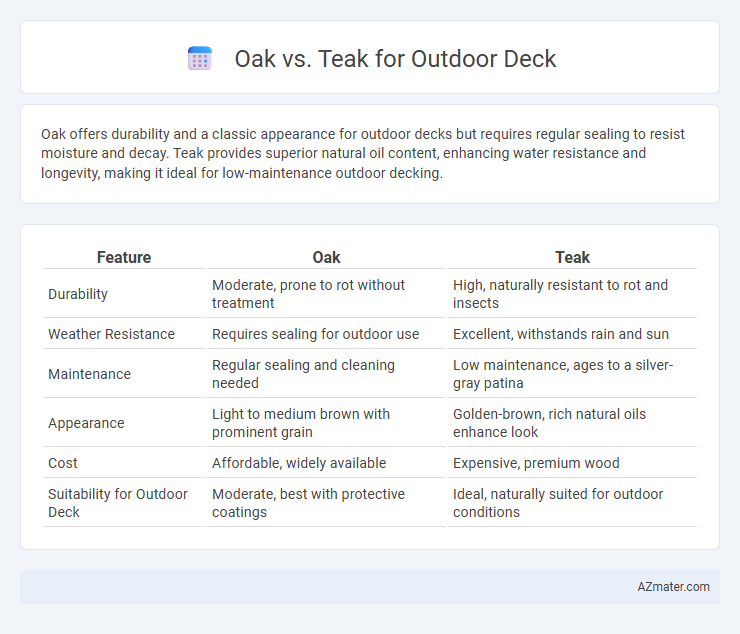Oak offers durability and a classic appearance for outdoor decks but requires regular sealing to resist moisture and decay. Teak provides superior natural oil content, enhancing water resistance and longevity, making it ideal for low-maintenance outdoor decking.
Table of Comparison
| Feature | Oak | Teak |
|---|---|---|
| Durability | Moderate, prone to rot without treatment | High, naturally resistant to rot and insects |
| Weather Resistance | Requires sealing for outdoor use | Excellent, withstands rain and sun |
| Maintenance | Regular sealing and cleaning needed | Low maintenance, ages to a silver-gray patina |
| Appearance | Light to medium brown with prominent grain | Golden-brown, rich natural oils enhance look |
| Cost | Affordable, widely available | Expensive, premium wood |
| Suitability for Outdoor Deck | Moderate, best with protective coatings | Ideal, naturally suited for outdoor conditions |
Introduction: Comparing Oak and Teak for Outdoor Decks
Oak and teak are popular hardwood choices for outdoor decks, each offering distinct qualities in durability and appearance. Oak provides a dense grain and strong resistance to wear, making it suitable for high-traffic areas, while teak naturally contains oils that resist water, rot, and insects, enhancing its longevity in outdoor environments. Selecting between oak and teak depends on budget, maintenance preferences, and desired aesthetic, with teak generally requiring less upkeep but commanding a higher price point.
Durability: How Oak and Teak Withstand Outdoor Elements
Teak is renowned for its exceptional durability in outdoor environments due to its high oil content and natural resistance to water, rot, and insect damage, making it ideal for decks exposed to harsh weather conditions. Oak, particularly white oak, offers strong resistance to moisture and decay but requires regular sealing and maintenance to prevent warping and splintering over time. Both woods demonstrate impressive longevity, but teak's superior weatherproof qualities typically result in less upkeep and a longer lifespan for outdoor decking applications.
Weather Resistance: Moisture, Sun, and Temperature Impacts
Teak outperforms oak in weather resistance due to its high natural oil content, which provides exceptional protection against moisture, sun, and temperature fluctuations, preventing warping and decay. Oak tends to absorb more water, making it susceptible to swelling, cracking, and fungal growth when exposed to constant moisture and varying outdoor temperatures. While both woods can be treated for outdoor use, teak's dense grain structure and inherent durability make it a superior choice for long-lasting outdoor decks in harsh weather conditions.
Maintenance Needs: Upkeep for Oak vs Teak Decking
Oak decking requires regular sealing and staining to protect against moisture and rot, as its porous structure absorbs water more easily. Teak's natural oils provide superior resistance to weathering and pests, reducing the frequency of maintenance such as sealing and refinishing. While oak demands more frequent upkeep to maintain durability and appearance, teak offers a low-maintenance solution ideal for long-lasting outdoor decks.
Appearance and Aesthetic Qualities
Oak features a traditional, rustic grain pattern with light to medium brown tones that age to a soft silver-gray, providing a classic and timeless look for outdoor decks. Teak boasts a rich golden-brown color with a smooth, straight grain and high natural oil content, giving it a luxurious appearance that deepens to a warm, reddish-brown over time. Both woods offer distinct aesthetic qualities: oak's rugged texture complements casual styles, while teak's refined elegance suits upscale outdoor spaces.
Cost Comparison: Initial Investment and Long-Term Value
Oak decking generally has a lower initial cost compared to teak, making it a budget-friendly choice for outdoor projects. However, teak offers greater durability, natural resistance to weather and pests, reducing maintenance expenses and extending lifespan, which enhances long-term value. Considering lifecycle costs, teak's higher upfront investment often results in better cost-efficiency over time due to its minimal upkeep and lasting performance.
Sustainability and Environmental Impact
Oak and teak are popular choices for outdoor decking, with oak being a more sustainable option due to its fast growth and availability from responsibly managed forests. Teak, sourced primarily from tropical rainforests, often carries a higher environmental impact because of deforestation and longer growth cycles despite its natural durability. Opting for certified oak ensures reduced ecological footprint and supports sustainable forestry practices, making it a greener choice for eco-conscious decking projects.
Installation: Ease of Working with Oak and Teak
Oak offers excellent ease of working due to its stability and straightforward machining, making it a popular choice for outdoor deck installation. Teak's natural oils provide resistance to moisture but can make cutting and fastening more challenging, requiring specialized tools and pre-drilling. Both woods demand proper sealing and finishing to ensure durability, but oak tends to be more user-friendly for DIY installers and contractors alike.
Longevity and Lifespan Expectations
Oak and teak are both popular choices for outdoor decking due to their durability, but teak significantly outperforms oak in terms of longevity and lifespan expectations. Teak contains natural oils that resist moisture, decay, insects, and weathering, allowing it to last 40 to 50 years or more with proper maintenance. In contrast, oak, especially white oak, can last around 20 to 30 years outdoors but requires regular sealing and treatment to prevent rot and insect damage.
Conclusion: Choosing the Best Wood for Your Outdoor Deck
Oak offers exceptional durability and resistance to wear, making it ideal for outdoor decks that endure heavy foot traffic, while teak provides superior natural oils that enhance weather resistance and longevity in humid or wet climates. Teak's rich, golden hue deepens gracefully over time without requiring extensive maintenance, whereas oak typically needs regular sealing to prevent moisture damage. Selecting the best wood depends on your climate, maintenance willingness, and aesthetic preferences, with teak excelling in moisture-prone environments and oak performing well in temperate, drier settings.

Infographic: Oak vs Teak for Outdoor Deck
 azmater.com
azmater.com